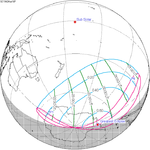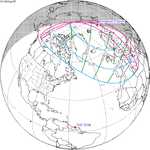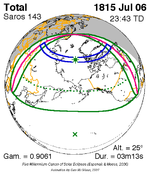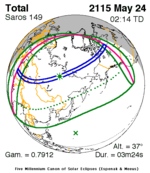Loading AI tools
Total eclipse From Wikipedia, the free encyclopedia
A total solar eclipse occurred at the Moon's ascending node of orbit on Sunday, September 21, 1941,[1][2][3][4][5][6] with a magnitude of 1.0379. A solar eclipse occurs when the Moon passes between Earth and the Sun, thereby totally or partly obscuring the image of the Sun for a viewer on Earth. A total solar eclipse occurs when the Moon's apparent diameter is larger than the Sun's, blocking all direct sunlight, turning day into darkness. Totality occurs in a narrow path across Earth's surface, with the partial solar eclipse visible over a surrounding region thousands of kilometres wide. Occurring about 2.25 days before perigee (on September 23, 1941, at 10:40 UTC), the Moon's apparent diameter was larger.[7]
The path of totality crossed the Soviet Union (today's Russia, Kazakhstan and Kyrgyzstan), China, Taiwan, Okinawa Prefecture and South Seas Mandate (the parts now belonging to Northern Mariana and Marshall Islands) in Japan, and ended in the Pacific Ocean. A partial eclipse was visible for most of Asia, Northern Australia, and northern Oceania.
The Chinese Solar Eclipse Observation Committee sent two teams - one led by Zhang Yuzhe and Gao Lu to the Taiyue Temple in Lintao County, Gansu,[8][9] and the other to Chong'an County (now Wuyishan City), Fujian.[10] The Lintao team started from Kunming, where a number of universities and institutes of higher education were evacuated during the war, on June 30, 1941, and arrived in Lintao on August 13. They traveled by car for a total of 3,200 kilometres and made science popularization speeches along the way.[8]
China was under the rule of the Republic of China and the eclipse occurred during the Second Sino-Japanese War. An artillery regiment was stationed near Lintao, and 20 fighter jets were stationed at Lanzhou Airport ready to intercept Japanese planes. The foggy weather in Lintao suddenly cleared up during the eclipse, making the observation successful. The solar chromosphere spectrum, a movie of the process of the eclipse and three corona images were taken. The brightness of the corona was measured to be 0.37 times that of the full moon. In Chong'an, the cloudy weather resulted in poor results of astronomical observations, but data of the change in Earth's magnetic field during the total phase was still measured.[11][10]
In November 1934, astronomer Gao Lu organized the Chinese Solar Eclipse Observation Committee to prepare for observations of the solar eclipse of June 19, 1936 and this eclipse in 1941.[11][8] Due to the Soviet-German War and the Second Sino-Japanese War, European and American astronomers did not make field observations in the Soviet Union and China.[12]
Several universities in Japan made observations in Ishigaki Island in Okinawa, Pengjia Islet in Taiwan under Japanese rule, and Chinese sites including Dongyin Island in Fujian, Nanchang in Jiangxi, Heshengqiao in Xianning, Hubei, Yanzhou in Jiayu, Hubei, and Hankou (now in Wuhan). Among them, Ishigaki Island had the sunniest weather and the most successful observation results. Results were poor due to thick clouds in Heshengqiao and Yanzhou where teams of Tokyo Imperial University, Kyoto Imperial University, and Tohoku Imperial University went.[13]
The Academy of Sciences of the Soviet Union began preparations in 1939. It was originally planned to involve 28 agencies, but due to the outbreak of World War II, only 7 observation teams were formed. The observation sites were Almaty and Kyzylorda in present-day Kazakhstan. The weather was good in Almaty with many observation results, while there were some clouds in Kyzylorda but several image were still taken.[14] European and American astronomers did not went to the Soviet Union due to the war.[12]
Shown below are two tables displaying details about this particular solar eclipse. The first table outlines times at which the moon's penumbra or umbra attains the specific parameter, and the second table describes various other parameters pertaining to this eclipse.[15]
| Event | Time (UTC) |
|---|---|
| First Penumbral External Contact | 1941 September 21 at 01:58:50.4 UTC |
| First Umbral External Contact | 1941 September 21 at 02:59:55.7 UTC |
| First Central Line | 1941 September 21 at 03:00:37.1 UTC |
| First Umbral Internal Contact | 1941 September 21 at 03:01:18.4 UTC |
| Equatorial Conjunction | 1941 September 21 at 04:18:15.8 UTC |
| Greatest Eclipse | 1941 September 21 at 04:34:02.9 UTC |
| Greatest Duration | 1941 September 21 at 04:35:22.1 UTC |
| Ecliptic Conjunction | 1941 September 21 at 04:38:53.8 UTC |
| Last Umbral Internal Contact | 1941 September 21 at 06:06:56.6 UTC |
| Last Central Line | 1941 September 21 at 06:07:40.0 UTC |
| Last Umbral External Contact | 1941 September 21 at 06:08:23.3 UTC |
| Last Penumbral External Contact | 1941 September 21 at 07:09:18.6 UTC |
| Parameter | Value |
|---|---|
| Eclipse Magnitude | 1.03791 |
| Eclipse Obscuration | 1.07725 |
| Gamma | 0.46494 |
| Sun Right Ascension | 11h51m55.1s |
| Sun Declination | +00°52'33.2" |
| Sun Semi-Diameter | 15'55.9" |
| Sun Equatorial Horizontal Parallax | 08.8" |
| Moon Right Ascension | 11h52m29.0s |
| Moon Declination | +01°18'57.7" |
| Moon Semi-Diameter | 16'17.7" |
| Moon Equatorial Horizontal Parallax | 0°59'48.1" |
| ΔT | 25.2 s |
This eclipse is part of an eclipse season, a period, roughly every six months, when eclipses occur. Only two (or occasionally three) eclipse seasons occur each year, and each season lasts about 35 days and repeats just short of six months (173 days) later; thus two full eclipse seasons always occur each year. Either two or three eclipses happen each eclipse season. In the sequence below, each eclipse is separated by a fortnight.
| September 5 Descending node (full moon) | September 21 Ascending node (new moon) |
|---|---|
 |  |
| Partial lunar eclipse Lunar Saros 117 | Total solar eclipse Solar Saros 143 |
This eclipse is a member of a semester series. An eclipse in a semester series of solar eclipses repeats approximately every 177 days and 4 hours (a semester) at alternating nodes of the Moon's orbit.[16]
The partial solar eclipse on August 12, 1942 occurs in the next lunar year eclipse set.
| Solar eclipse series sets from 1939 to 1942 | ||||||
|---|---|---|---|---|---|---|
| Descending node | Ascending node | |||||
| Saros | Map | Gamma | Saros | Map | Gamma | |
| 118 | April 19, 1939 Annular |
0.9388 | 123 | October 12, 1939 Total |
−0.9737 | |
| 128 | April 7, 1940 Annular |
0.219 | 133 | October 1, 1940 Total |
−0.2573 | |
| 138 | March 27, 1941 Annular |
−0.5025 | 143 | September 21, 1941 Total |
0.4649 | |
| 148 | March 16, 1942 Partial |
−1.1908 | 153 | September 10, 1942 Partial |
1.2571 | |
This eclipse is a part of Saros series 143, repeating every 18 years, 11 days, and containing 72 events. The series started with a partial solar eclipse on March 7, 1617. It contains total eclipses from June 24, 1797 through October 24, 1995; hybrid eclipses from November 3, 2013 through December 6, 2067; and annular eclipses from December 16, 2085 through September 16, 2536. The series ends at member 72 as a partial eclipse on April 23, 2897. Its eclipses are tabulated in three columns; every third eclipse in the same column is one exeligmos apart, so they all cast shadows over approximately the same parts of the Earth.
The longest duration of totality was produced by member 16 at 3 minutes, 50 seconds on August 19, 1887, and the longest duration of annularity will be produced by member 51 at 4 minutes, 54 seconds on September 6, 2518. All eclipses in this series occur at the Moon’s ascending node of orbit.[17]
| Series members 12–33 occur between 1801 and 2200: | ||
|---|---|---|
| 12 | 13 | 14 |
 July 6, 1815 |
 July 17, 1833 |
 July 28, 1851 |
| 15 | 16 | 17 |
 August 7, 1869 |
 August 19, 1887 |
 August 30, 1905 |
| 18 | 19 | 20 |
 September 10, 1923 |
 September 21, 1941 |
 October 2, 1959 |
| 21 | 22 | 23 |
 October 12, 1977 |
 October 24, 1995 |
 November 3, 2013 |
| 24 | 25 | 26 |
 November 14, 2031 |
 November 25, 2049 |
 December 6, 2067 |
| 27 | 28 | 29 |
 December 16, 2085 |
 December 29, 2103 |
 January 8, 2122 |
| 30 | 31 | 32 |
 January 20, 2140 |
 January 30, 2158 |
 February 10, 2176 |
| 33 | ||
 February 21, 2194 | ||
The metonic series repeats eclipses every 19 years (6939.69 days), lasting about 5 cycles. Eclipses occur in nearly the same calendar date. In addition, the octon subseries repeats 1/5 of that or every 3.8 years (1387.94 days). All eclipses in this table occur at the Moon's ascending node.
| 22 eclipse events between December 2, 1880 and July 9, 1964 | ||||
|---|---|---|---|---|
| December 2–3 | September 20–21 | July 9–10 | April 26–28 | February 13–14 |
| 111 | 113 | 115 | 117 | 119 |
 December 2, 1880 |
 July 9, 1888 |
 April 26, 1892 |
 February 13, 1896 | |
| 121 | 123 | 125 | 127 | 129 |
 December 3, 1899 |
 September 21, 1903 |
 July 10, 1907 |
 April 28, 1911 |
 February 14, 1915 |
| 131 | 133 | 135 | 137 | 139 |
 December 3, 1918 |
 September 21, 1922 |
 July 9, 1926 |
 April 28, 1930 |
 February 14, 1934 |
| 141 | 143 | 145 | 147 | 149 |
 December 2, 1937 |
 September 21, 1941 |
 July 9, 1945 |
 April 28, 1949 |
 February 14, 1953 |
| 151 | 153 | 155 | ||
 December 2, 1956 |
 September 20, 1960 |
 July 9, 1964 | ||
This eclipse is a part of a tritos cycle, repeating at alternating nodes every 135 synodic months (≈ 3986.63 days, or 11 years minus 1 month). Their appearance and longitude are irregular due to a lack of synchronization with the anomalistic month (period of perigee), but groupings of 3 tritos cycles (≈ 33 years minus 3 months) come close (≈ 434.044 anomalistic months), so eclipses are similar in these groupings.
The partial solar eclipses on December 7, 2170 (part of Saros 164) and November 7, 2181 (part of Saros 165) are also a part of this series but are not included in the table below.
| Series members between 1801 and 2105 | ||||
|---|---|---|---|---|
 September 28, 1810 (Saros 131) |
 August 27, 1821 (Saros 132) |
 July 27, 1832 (Saros 133) |
 June 27, 1843 (Saros 134) |
 May 26, 1854 (Saros 135) |
 April 25, 1865 (Saros 136) |
 March 25, 1876 (Saros 137) |
 February 22, 1887 (Saros 138) |
 January 22, 1898 (Saros 139) |
 December 23, 1908 (Saros 140) |
 November 22, 1919 (Saros 141) |
 October 21, 1930 (Saros 142) |
 September 21, 1941 (Saros 143) |
 August 20, 1952 (Saros 144) |
 July 20, 1963 (Saros 145) |
 June 20, 1974 (Saros 146) |
 May 19, 1985 (Saros 147) |
 April 17, 1996 (Saros 148) |
 March 19, 2007 (Saros 149) |
 February 15, 2018 (Saros 150) |
 January 14, 2029 (Saros 151) |
 December 15, 2039 (Saros 152) |
 November 14, 2050 (Saros 153) |
 October 13, 2061 (Saros 154) |
 September 12, 2072 (Saros 155) |
 August 13, 2083 (Saros 156) |
 July 12, 2094 (Saros 157) |
 June 12, 2105 (Saros 158) | ||
This eclipse is a part of the long period inex cycle, repeating at alternating nodes, every 358 synodic months (≈ 10,571.95 days, or 29 years minus 20 days). Their appearance and longitude are irregular due to a lack of synchronization with the anomalistic month (period of perigee). However, groupings of 3 inex cycles (≈ 87 years minus 2 months) comes close (≈ 1,151.02 anomalistic months), so eclipses are similar in these groupings.
| Series members between 1801 and 2200 | ||
|---|---|---|
 December 9, 1825 (Saros 139) |
 November 20, 1854 (Saros 140) |
 October 30, 1883 (Saros 141) |
 October 10, 1912 (Saros 142) |
 September 21, 1941 (Saros 143) |
 August 31, 1970 (Saros 144) |
 August 11, 1999 (Saros 145) |
 July 22, 2028 (Saros 146) |
 July 1, 2057 (Saros 147) |
 June 11, 2086 (Saros 148) |
 May 24, 2115 (Saros 149) |
 May 3, 2144 (Saros 150) |
 April 12, 2173 (Saros 151) |
||
Seamless Wikipedia browsing. On steroids.
Every time you click a link to Wikipedia, Wiktionary or Wikiquote in your browser's search results, it will show the modern Wikiwand interface.
Wikiwand extension is a five stars, simple, with minimum permission required to keep your browsing private, safe and transparent.